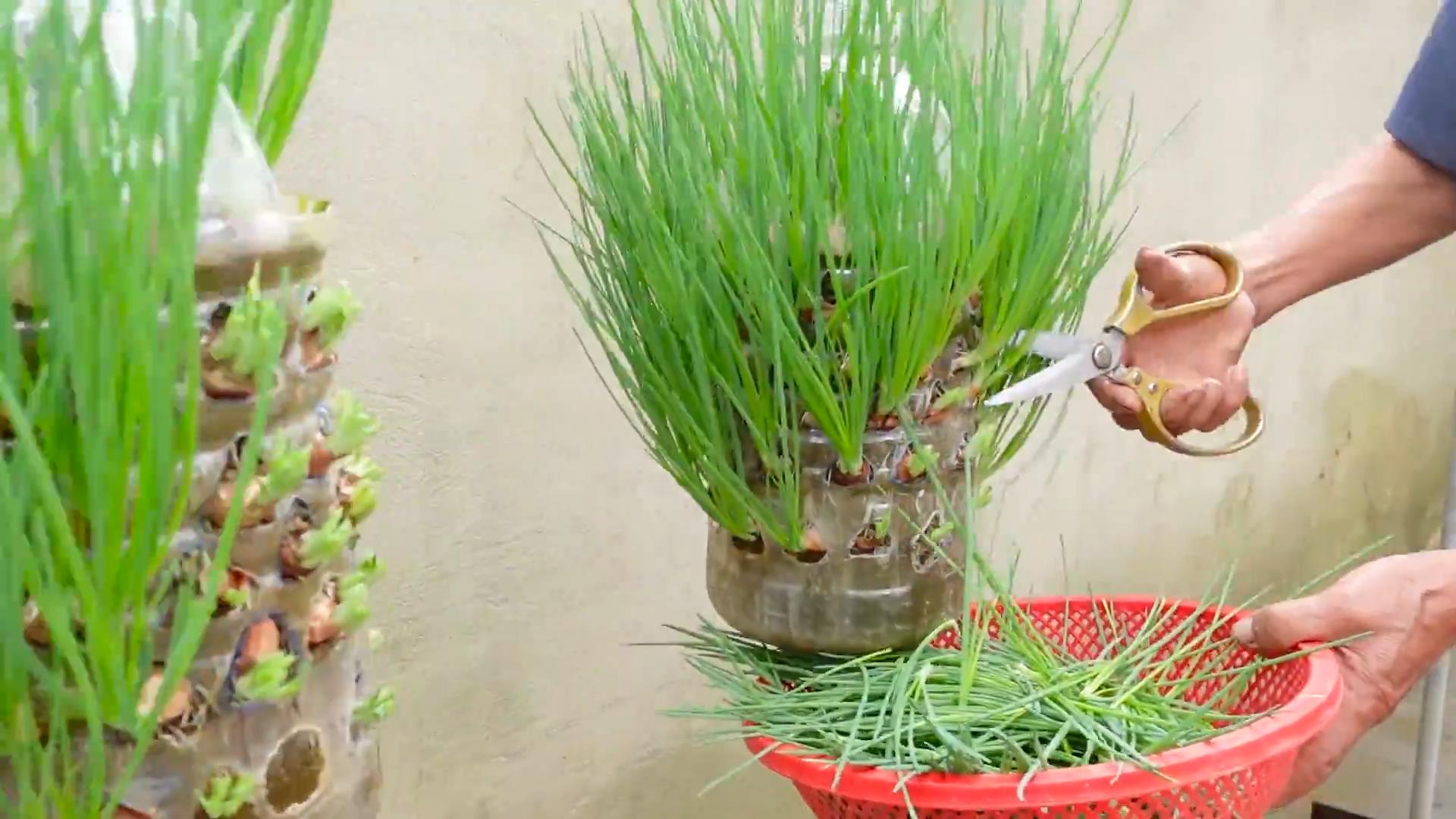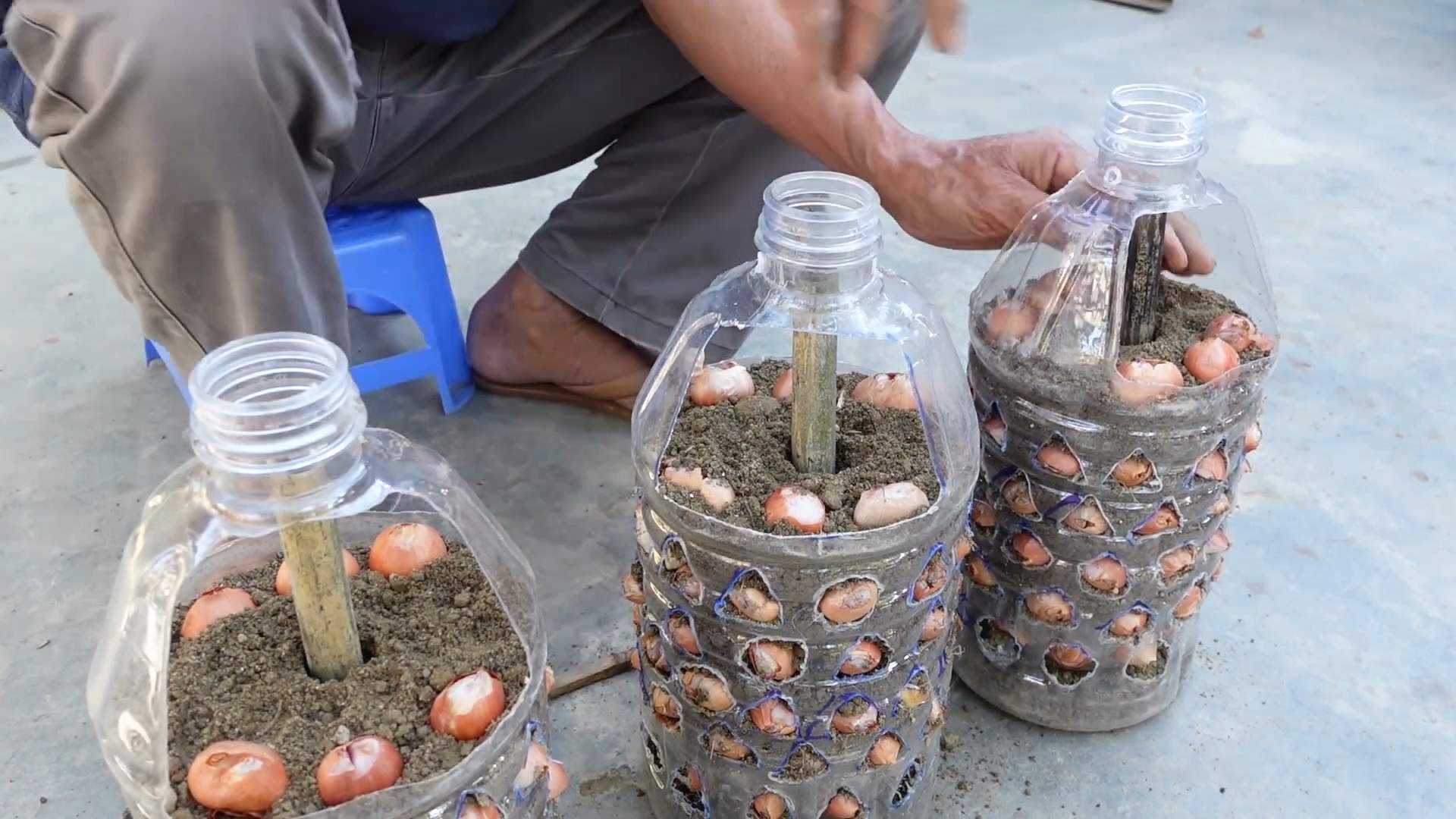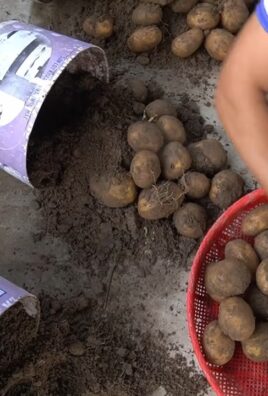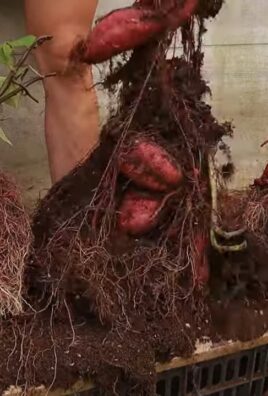Continuous onion harvest – the holy grail of home gardening, right? Imagine never having to buy onions from the store again, always having a fresh supply ready to add that perfect zing to your dishes. Sounds like a dream? Well, it doesn’t have to be! For centuries, gardeners have been perfecting techniques to extend their harvests, and the humble onion is no exception. From ancient Egypt, where onions were revered and even used as currency, to modern-day kitchen gardens, this versatile vegetable has held a place of honor.
But let’s be honest, achieving a continuous onion harvest can feel a bit daunting. We’ve all been there – planting our onions with high hopes, only to find ourselves with a glut at one point and then…nothing. That’s where these DIY tricks and hacks come in! I’m going to share some simple, yet incredibly effective, methods to keep your onion supply flowing throughout the growing season. Whether you’re a seasoned gardener or just starting out, these tips will help you maximize your yield and enjoy fresh onions whenever you need them. So, grab your gardening gloves, and let’s dive into the secrets of a never-ending onion bounty!

Never Buy Onions Again: My Foolproof Guide to a Continuous Onion Harvest!
Hey there, fellow garden enthusiasts! Are you tired of constantly running to the grocery store for onions? I was too! That’s why I embarked on a mission to achieve a continuous onion harvest right in my own backyard. And guess what? I cracked the code! This guide will walk you through my tried-and-true method, ensuring you always have fresh onions on hand. Get ready to say goodbye to store-bought onions forever!
Understanding the Secret: Bunching Onions (Scallions)
The key to this continuous harvest isn’t about growing massive globe onions. Instead, we’re focusing on bunching onions, also known as scallions or green onions. These are incredibly versatile, quick to grow, and perfect for snipping as needed. Plus, they have a fantastic ability to regrow after being harvested!
Here’s why bunching onions are perfect for a continuous harvest:
* Rapid Growth: They mature much faster than bulb onions.
* Regrowth Power: They readily regrow from the base after cutting.
* Space-Saving: They don’t require a lot of space, making them ideal for small gardens or containers.
* Easy to Harvest: Simply snip off what you need, when you need it.
* Delicious Flavor: They offer a mild, fresh onion flavor perfect for salads, soups, and garnishes.
Materials You’ll Need
Before we dive in, let’s gather our supplies. This is a pretty straightforward project, so you probably have most of these items already:
* Bunching Onion Seeds or Sets: I prefer seeds for a wider variety, but sets (small bulbs) will give you a head start.
* Potting Soil (if using containers): Choose a well-draining mix.
* Garden Soil (if planting directly in the ground): Amend with compost for added nutrients.
* Gardening Gloves: To keep your hands clean and protected.
* Watering Can or Hose: For regular watering.
* Scissors or Garden Shears: For harvesting.
* Optional: Fertilizer: A balanced fertilizer can boost growth.
* Optional: Containers: Pots, raised beds, or even repurposed containers will work.
Getting Started: Planting Your Bunching Onions
This is where the magic begins! Whether you’re starting from seeds or sets, the planting process is relatively simple.
Planting from Seeds
1. Prepare the Soil: Whether you’re using containers or planting directly in the ground, make sure the soil is loose and well-draining. If using containers, fill them with potting soil. If planting in the ground, amend the soil with compost to improve fertility and drainage.
2. Sow the Seeds: Sprinkle the seeds thinly over the soil surface. You can create shallow furrows (about ¼ inch deep) to help with even spacing.
3. Cover the Seeds: Gently cover the seeds with a thin layer of soil.
4. Water Thoroughly: Water the soil gently but thoroughly, making sure not to dislodge the seeds.
5. Keep Moist: Keep the soil consistently moist until the seeds germinate. This usually takes about 7-14 days.
6. Thin Seedlings (if needed): Once the seedlings emerge, thin them out so they are about 1-2 inches apart. This will give them enough room to grow.
Planting from Sets
1. Prepare the Soil: Just like with seeds, ensure the soil is loose and well-draining. Amend with compost if necessary.
2. Create Holes: Dig small holes about 1-2 inches deep and 1-2 inches apart.
3. Plant the Sets: Place one onion set in each hole, with the root end facing down.
4. Cover the Sets: Cover the sets with soil, leaving the very tip of the bulb exposed.
5. Water Thoroughly: Water the soil gently but thoroughly.
Maintaining Your Onion Patch: Watering, Fertilizing, and More
Once your onions are planted, it’s important to provide them with the right care to ensure a healthy and continuous harvest.
1. Watering: Bunching onions need consistent moisture, especially during hot weather. Water them regularly, keeping the soil consistently moist but not waterlogged. Check the soil moisture by sticking your finger about an inch deep. If it feels dry, it’s time to water.
2. Fertilizing (Optional): While not essential, fertilizing can boost growth and yield. Use a balanced fertilizer (e.g., 10-10-10) diluted to half strength. Apply it every 2-3 weeks during the growing season. I personally like to use compost tea as a natural fertilizer.
3. Weeding: Keep the area around your onions free of weeds. Weeds compete for nutrients and water, hindering onion growth. Hand-pull weeds carefully to avoid disturbing the onion roots.
4. Sunlight: Bunching onions thrive in full sun (at least 6 hours of direct sunlight per day). If you’re growing them indoors, make sure they get plenty of light from a sunny window or grow lights.
5. Pest Control: Bunching onions are generally pest-resistant, but keep an eye out for common garden pests like aphids or thrips. If you spot any pests, treat them with insecticidal soap or neem oil.
The Exciting Part: Harvesting for a Continuous Supply
This is where the magic happens! The key to a continuous harvest is to harvest correctly.
1. When to Harvest: You can start harvesting bunching onions when they are about 6-8 inches tall. This usually takes about 60-70 days from seed or 30-40 days from sets.
2. How to Harvest: The most important thing is to **never pull the entire plant out of the ground**. Instead, use scissors or garden shears to cut the green tops about 1-2 inches above the soil level.
3. Leave the Base: By leaving the base of the plant intact, it will regrow new shoots, providing you with a continuous supply of onions.
4. Harvest Regularly: Harvest your onions regularly to encourage new growth. You can harvest them every week or two, depending on how quickly they grow.
5. Succession Planting: For an even more reliable supply, consider succession planting. This means planting new seeds or sets every few weeks. This way, you’ll always have new onions coming up as you harvest the older ones.
Troubleshooting: Common Issues and Solutions
Even with the best care, you might encounter a few challenges along the way. Here are some common issues and how to address them:
* Yellowing Leaves: This could be a sign of overwatering, underwatering, or nutrient deficiency. Check the soil moisture and adjust your watering accordingly. If the soil is consistently moist, reduce watering. If it’s dry, water more frequently. You can also try fertilizing with a balanced fertilizer.
* Slow Growth: Slow growth can be caused by insufficient sunlight, poor soil, or lack of nutrients. Make sure your onions are getting at least 6 hours of direct sunlight per day. Amend the soil with compost to improve fertility and drainage. Fertilize regularly with a balanced fertilizer.
* Pest Infestation: Keep an eye out for common garden pests like aphids or thrips. Treat them with insecticidal soap or neem oil. You can also try attracting beneficial insects like ladybugs, which will prey on the pests.
* Bolting (Flowering): If your onions start to bolt (produce flower stalks), it means they are stressed. This can be caused by temperature fluctuations, lack of water, or poor soil. Remove the flower stalks to encourage the plant to focus on producing leaves.
Beyond the Basics: Advanced Tips for Onion Success
Want to take your onion game to the next level? Here are a few advanced tips:
* Companion Planting: Plant your onions alongside other beneficial plants. Carrots, for example, repel onion flies, while onions repel carrot flies. Other good companion plants for onions include chamomile, marigolds, and rosemary.
* Succession Planting: As mentioned earlier, succession planting is a great way to ensure a continuous supply of onions. Plant new seeds or sets every few weeks to keep the harvest coming.
* Overwintering: In mild climates, you can overwinter bunching onions for an even earlier harvest in the spring. Simply leave the plants in the ground over the winter and they will start growing again in the spring.
* Saving Seeds: If you want to save seeds from your bunching onions, allow a few plants to flower and produce seeds. Once the seed heads are dry and brown, harvest them and store the seeds in a cool, dry place.
* Experiment with Varieties: There are many different varieties of bunching onions to choose from. Experiment

Conclusion
So, there you have it! The secret to a continuous onion harvest, right at your fingertips. This isn’t just about saving a few trips to the grocery store; it’s about embracing a more sustainable and rewarding way to grow your own food. Imagine the satisfaction of knowing that the flavorful onions you’re adding to your dishes came directly from your own garden, thanks to this simple yet effective DIY trick.
Why is this a must-try? Because it’s efficient, cost-effective, and incredibly satisfying. Instead of planting a whole new batch of onion sets every time you need fresh onions, you’re essentially recycling the ones you already have. This method extends your harvest season, providing you with a steady supply of fresh onions for a longer period. Plus, it’s a fantastic way to reduce food waste and connect with the natural cycle of growth.
But the beauty of this DIY trick lies in its adaptability. Feel free to experiment with different varieties of onions to see which ones thrive best in your garden. You can also try planting the onion bottoms in different types of soil or containers to optimize their growth. Consider companion planting with herbs like rosemary or thyme, which can help deter pests and enhance the flavor of your onions.
Don’t be afraid to get creative! Perhaps you could even set up a small indoor onion garden using this method, allowing you to enjoy fresh onions year-round, regardless of the weather outside. The possibilities are endless.
We wholeheartedly encourage you to give this continuous onion harvest method a try. It’s a simple, rewarding, and sustainable way to enjoy fresh onions from your garden for an extended period. Once you’ve experienced the joy of harvesting your own homegrown onions, you’ll never look at store-bought onions the same way again.
And most importantly, we want to hear about your experiences! Share your successes, your challenges, and any variations you’ve tried in the comments below. Let’s build a community of gardeners who are passionate about sustainable and rewarding growing practices. Your insights could inspire others to embark on their own continuous onion harvest journey. So, grab your gardening gloves, get your hands dirty, and let’s start growing!
Frequently Asked Questions (FAQ)
What exactly is a “continuous onion harvest,” and why should I care?
A continuous onion harvest refers to a method of growing onions that allows you to harvest them over an extended period, rather than just once a season. This is achieved by replanting the bottom portion of harvested onions, which then regrow into new onions. You should care because it’s a sustainable, cost-effective, and space-saving way to enjoy fresh onions from your garden for a longer time. It reduces food waste and provides a consistent supply of this essential vegetable.
What kind of onions work best for this method?
Generally, any type of onion can be used, but some varieties tend to be more successful than others. Yellow onions, white onions, and red onions all work well. Experiment to see which varieties thrive best in your specific climate and soil conditions. Consider starting with onions that you already know grow well in your area. Sweet onions may not store as well, so they might be better suited for immediate replanting.
How do I prepare the onion bottoms for replanting?
After harvesting an onion, cut off the bottom portion, leaving about an inch or two of the root end attached. Make sure there’s some visible root structure. Let the cut end dry out for a day or two to prevent rotting. This allows the cut surface to callous over, protecting it from infection.
What kind of soil is best for replanting onion bottoms?
Onions prefer well-drained soil that is rich in organic matter. Amend your soil with compost or well-rotted manure before planting. A slightly acidic to neutral pH (around 6.0 to 7.0) is ideal. If your soil is heavy clay, consider adding sand or perlite to improve drainage.
How deep should I plant the onion bottoms?
Plant the onion bottoms deep enough so that the roots are covered with soil, but the top of the cut end is just above the soil surface. This prevents the cut end from rotting. Space them about 4-6 inches apart to allow for adequate growth.
How often should I water the replanted onion bottoms?
Water regularly, especially during dry periods. Keep the soil consistently moist, but not waterlogged. Overwatering can lead to root rot. A good rule of thumb is to water when the top inch of soil feels dry to the touch.
How long does it take for the onion bottoms to regrow into new onions?
The time it takes for the onion bottoms to regrow depends on several factors, including the variety of onion, the climate, and the soil conditions. Generally, you can expect to see new growth within a few weeks. It may take several months for the onions to reach full size.
Do I need to fertilize the replanted onion bottoms?
Yes, fertilizing can help promote healthy growth. Use a balanced fertilizer or one that is specifically formulated for vegetables. Apply the fertilizer according to the package directions. You can also side-dress with compost or well-rotted manure.
What are some common problems I might encounter, and how can I prevent them?
Common problems include onion maggots, thrips, and fungal diseases. To prevent these problems, practice good garden hygiene, such as removing plant debris and rotating crops. You can also use organic pest control methods, such as neem oil or insecticidal soap. Ensure good air circulation to prevent fungal diseases.
Can I do this indoors?
Yes, you can grow onions indoors using this method. Choose a sunny location or use grow lights. Use a well-draining potting mix and ensure adequate drainage. Monitor the moisture levels carefully, as indoor environments can be drier than outdoor gardens.
What if the onion bottom rots instead of growing?
Rotting is usually caused by overwatering or poor drainage. Make sure the soil is well-draining and avoid overwatering. Let the cut end of the onion bottom dry out completely before planting. If you suspect a fungal infection, you can treat the soil with a fungicide.
How do I know when the new onions are ready to harvest?
The onions are ready to harvest when the tops start to fall over and turn yellow or brown. You can also gently dig around the base of the onion to check its size. Harvest the onions on a dry day and allow them to cure in a well-ventilated area for a week or two before storing them.
Can I use this method to grow green onions (scallions)?
Yes, this method works exceptionally well for growing green onions. Simply replant the white bottom portion of the green onion with the roots attached. You can harvest the green tops as needed.
Is this method truly “continuous”? Can I keep replanting the same onion bottoms indefinitely?
While the term “continuous” is used, it’s not truly indefinite. The onion bottoms will eventually lose their vigor and stop producing. However, you can extend the harvest season significantly by replanting the bottoms multiple times. It’s a good idea to start new onions from seed or sets each year to ensure a continuous supply.




Leave a Comment